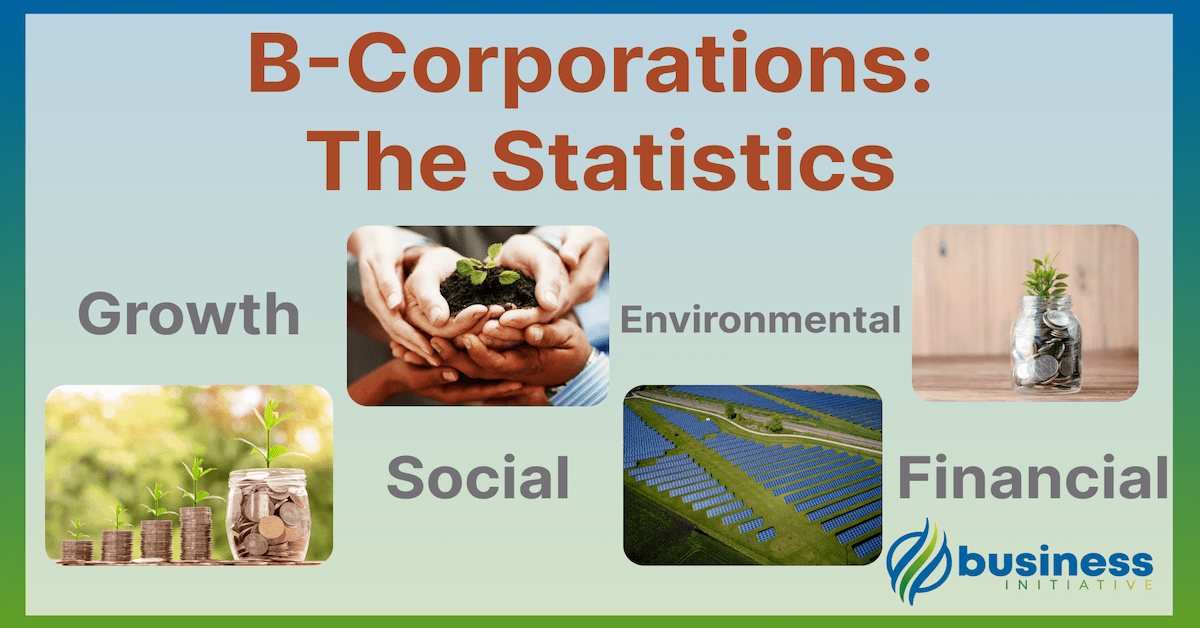In today’s business landscape, more and more entrepreneurs are seeking to balance profit with purpose.
Enter B Corps, a unique type of business structure that combines the best of both traditional corporations and non-profit organizations.
B Corps, or Benefit Corporations, are for-profit companies that prioritize social and environmental responsibility alongside financial success.
In this article, we’ll explore the numbers behind B Corps, shedding light on their growth trends, social and environmental impact, and the factors that contribute to their success.
If you’re a business owner or entrepreneur considering this path, read on to discover why B Corps might be the perfect fit for your company.
Growth Trends - B Corps on the Rise
Since the first B Corp was certified in 2007, there has been a remarkable growth in their numbers and global presence.
In the United States, the number of B Corps has increased dramatically over the past decade.
In 2010, there were just 205 certified B Corps; by 2020, that number had surged to over 3,500 (source).

As of September 2021, there were more than 4,000 B Corps across 77 countries and 153 industries (source).
Globally, the B Corp movement has expanded significantly, with strong growth in regions like Europe and Latin America.
Between 2015 and 2020, the annual growth rate of B Corps in North America was approximately 23%, demonstrating a clear upward trend in popularity (source).
In addition, the number of B Corps with more than 100 employees has doubled since 2018, indicating that larger companies are also embracing the B Corp model (source).
Other regions have also seen impressive growth rates.
In Asia, for example, the number of B Corps grew by over 300% between 2016 and 2020 (source).
Similarly, Africa has experienced a surge in B Corps, with a five-fold increase between 2015 and 2020 (source).
These trends suggest that not only are more companies becoming interested in the B Corp model, but that it is also becoming more widely recognized and adopted globally.
This rapid growth can be attributed to several factors, such as increased consumer demand for ethically produced goods and services, a growing desire among entrepreneurs to build responsible businesses, and the recognition of B Corps as a viable business structure that balances profit and purpose.
Financial Impact of B-Corps on the Economy
B Corps are not only making a significant impact on the environment and society, but they are also creating economic value.
This growth is due in part to their commitment to sustainability and social responsibility, which attracts customers who prioritize these values.
According to a study by B Lab, B Corps grew 28 times faster than the national average for US businesses between 2011 and 2015 (source).
In addition, B Corps have been shown to outperform their peers financially.
A report by Real Leaders Magazine in partnership with Big Path Capital and B Lab Global Network found that the top 100 most impactful B Corps had an average revenue growth rate of 14.4%, compared to an average of 8.3% for the S&P 500 companies (source).
Furthermore, B Corps have access to a growing pool of impact investors who are looking for companies that align with their values.
In recent years, impact investing has become increasingly popular as investors seek to generate positive social and environmental outcomes alongside financial returns.
By becoming a B Corp, companies can tap into this growing market of impact investors and secure funding from sources that share their mission.
Overall, the success of B Corps demonstrates that it is possible to create economic value while also making a positive impact on society and the environment.
As more businesses adopt this model, we can expect to see even greater progress towards a more sustainable and equitable future.
Social and Environmental Impact: Making a Difference
B Corps are required to meet rigorous social and environmental performance standards, as well as transparency and accountability requirements.
As a result, these companies often boast impressive track records when it comes to environmental stewardship, worker well-being, and community engagement.

According to a study by B Lab, B Corps outperform traditional businesses in several key areas, including environmental performance, worker benefits, and community involvement (source).
In particular, B Corps are 55% more likely to cover at least some of their employees’ health insurance costs and 2.5 times more likely to give at least some of their employees paid time off to volunteer in their communities.
B Corps are also more likely to have diverse leadership teams, with women holding 33% of executive positions compared to just 21% in traditional businesses (source).
A study by the University of Oxford found that B Corps outperformed traditional businesses in terms of environmental impact, social impact, and financial performance.
The study analyzed data from 2,400 companies and found that B Corps scored higher in all three areas (source).
In addition to meeting rigorous standards for social and environmental responsibility, many B Corps also prioritize giving back to their communities through donations and volunteer work.
For example, Patagonia, a well-known B Corp, donates 1% of its annual sales to environmental causes and has been involved in numerous grassroots campaigns for conservation and sustainability (source).
The B Corp community has also made significant progress towards reducing their carbon footprint.
According to another B Lab report, 76% of B Corps in the United States have implemented measures to reduce their greenhouse gas emissions, compared to just 51% of non-certified businesses (source).
In terms of social impact, B Corps are committed to fair labor practices and ethical supply chains.
A study by the University of California found that B Corps were more likely to source materials from local suppliers and pay their workers a living wage (source).
Another area where B Corps excel is in gender equality.
As per a report by B Lab, 41% of B Corps have a formal policy promoting gender diversity and pay equity, compared to just 26% of non-certified businesses (source).
Additionally, B Corps are known for their commitment to giving back. Many companies donate a portion of their profits or products/services to charitable causes.
For example, Warby Parker, a popular eyewear company and certified B Corp, donates a pair of glasses for every pair sold and has distributed over 5 million pairs through its Buy a Pair, Give a Pair program (source).
Furthermore, according to an analysis by Real Leaders Magazine in partnership with Big Path Capital and B Lab Global Network, the top 100 most impactful B Corps have reduced their greenhouse gas emissions by 67%, saved over 900 million gallons of water, and diverted over 500,000 tons of waste from landfills (source).
B Corps are also making a significant impact on climate change.
In 2020, B Corps announced their commitment to reduce their greenhouse gas emissions by 45% by 2030, surpassing the goals of the Paris Agreement (source).
13 Factors That Sets B Corps Apart
Several factors contribute to the success of B Corps, enabling them to balance profit and purpose effectively.
1. A clear mission:
B Corps often have a well-defined mission that focuses on creating a positive impact on society and the environment.
This mission-driven approach helps them attract and retain customers, employees, and investors who share their values.
2. Strong accountability:
B Corps are legally required to consider the interests of all stakeholders, not just shareholders, which encourages them to prioritize long-term value creation over short-term profits.
3. Transparency:
B Corps must be transparent about their social and environmental performance, allowing consumers, investors, and other stakeholders to make informed decisions about their support.
4. Collaboration:
B Corps often collaborate with other like-minded organizations and join forces to tackle pressing social and environmental challenges.
5. Innovation:
B Corps are known for their innovative approaches to solving problems, often leveraging technology and creativity to drive positive change.
6. Access to capital:
B Corps have access to a growing pool of impact investors who are looking for companies that align with their values.
This can provide B Corps with the necessary funding to grow and expand their impact.
7. Employee engagement:
B Corps often prioritize employee well-being and engagement, which can result in higher job satisfaction and productivity.
This is especially important for attracting and retaining top talent.
8. Brand differentiation:
By becoming a B Corp, companies can differentiate themselves from competitors and appeal to consumers who value social and environmental responsibility.
This can lead to increased brand loyalty and customer retention.
9. Legal protection:
B Corps have legal protection to pursue their mission, even if it means sacrificing short-term profits.
This structure enables them to consider the long-term interests of all stakeholders without fear of legal repercussions.
10. Potential tax benefits:
In some states, B Corps may be eligible for tax incentives or other benefits that traditional corporations do not qualify for.
This can provide additional financial support for companies committed to making a positive impact on society and the environment.
11. Customer loyalty:
B Corps often attract customers who prioritize social and environmental responsibility, creating a loyal customer base that values the company’s mission as much as its products or services.
12. Positive impact beyond the business:
B Corps are known for their commitment to using business as a force for good, and many companies extend this mission beyond their core operations.
For example, some B Corps partner with local organizations to promote sustainability and social justice in their communities.
13. Influence on industry standards:
As more companies adopt the B Corp model, it is likely to influence industry standards and practices.
B Corps are already driving change in areas such as supply chain transparency and worker well-being, and this impact is likely to grow as the movement continues to gain momentum.
As more entrepreneurs seek to combine profit with purpose, the number of certified B Corps continues to grow at an impressive rate across the globe.
These companies stand out by prioritizing social and environmental responsibility alongside financial success, resulting in impressive impacts on climate change, worker well-being, community involvement, and much more.
By embracing a clear mission, strong accountability standards, transparency requirements, collaboration opportunities, innovative approaches, access to capital, employee engagement strategies, brand differentiation tactics, legal protections, and potential tax benefits, B Corps offer a unique business structure that balances profit with purpose in an increasingly conscious marketplace.
The Future of Business
As the B Corp movement continues to gain momentum, it’s clear that this innovative business structure offers significant advantages for entrepreneurs and business owners committed to making a positive impact on the world.
By prioritizing social and environmental responsibility alongside financial success, B Corps are leading the way toward a more sustainable, equitable, and prosperous future.
If you’re considering becoming a B Corp or simply want to learn more about how your business can make a difference, visit the B Corporation website to access valuable resources and connect with a community of like-minded entrepreneurs.
Together, we can redefine what it means to be a successful business in the 21st century.
Sources
- B Corporation Directory
- B Analytics: B Corp Data
- New Research Shows B Corps Are Outperforming Their Peers
- B Corps Commit to Net Zero Climate Ambition in Advance of COP26
- B Corporation Website
- New Research Shows B Corps Are Outperforming Their Peers
- The 100 Most Innovative and Impactful B Corps in 2021
- B Corporation Website
- Bcorporation.net
- University of Oxford Said Business School
- Patagonia.com
- B Corporation
- Berkley
- B Corporation
- Warby Parker
- Real-leaders.com


